Check out our range of stock.
Didn't find what you like?
Send us a message
Found something out of stock?
Send us a message
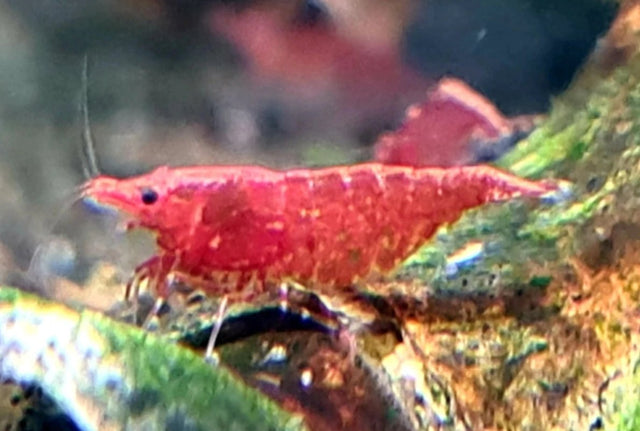
Discover the Captivating World of Freshwater Shrimp
Short Description:
Welcome to the ultimate destination for freshwater aquarium shrimp! Explore our curated collection of vibrant colors, unique patterns, and fascinating species. From beginner-friendly Neocaridina to expert-level Caridina, we offer healthy, premium-quality shrimp to transform your aquarium into a living masterpiece.
Why Choose Our Shrimp?
🎨 Vibrant Colors: From fiery reds to electric blues and sunny yellows
👨👩👧👦 Breeding Pairs & Colonies: Options for both enjoyment and propagation
🌿 Tank Cleaners: Natural algae eaters and waste management experts
💯 Quality Guaranteed: Carefully acclimated and health-inspected specimens
🚚 Safe Shipping: Expert packaging with live arrival guarantee
Shop By Experience Level
Beginner Friendly (Neocaridina)
Perfect for those new to shrimp keeping! These hardy species adapt to various water conditions and offer stunning colors with manageable care requirements.
Red Cherry Shrimp
Blue Dream Shrimp
Yellow Goldenback Shrimp
Green Jade Shrimp
Intermediate (Caridina)
For those ready to advance! These require more specific water parameters but reward you with extraordinary patterns and colors.
Crystal Red Shrimp
Crystal Black Shrimp
Mischling Shrimp
Tiger Shrimp
Expert Level (Taiwan Bee & Specialties)
The ultimate challenge for serious enthusiasts! These premium shrimp demand perfect conditions but offer unmatched beauty and breeding potential.
Blue Bolt Shrimp
Wine Red Pinto Shrimp
Shadow Panda Shrimp
King Kong Shrimp
Essential Shrimp Keeping Supplies
Set up your shrimp for success with our complete selection of:
Specialized Shrimp Foods & Minerals
Breeding Equipment & Hatcheries
Water Testing & Treatment
Shrimp-Safe Plant Fertilizers
Quarantine & Acclimation Supplies
Shop With Confidence
Our Promise:
🚚 Live Arrival Guarantee
🔬 Health & Quality Inspection
💧 Proper Acclimation Guidance
📞 Expert Support Team
📦 Climate-Appropriate Packaging
Shipping Note: We ship shrimp Monday-Wednesday via expedited shipping to ensure weekend-free delivery. Acclimation guide included with every order.
Join Thousands of Successful Shrimp Keepers!
"These are the healthiest shrimp I've ever received! The colors are even more vibrant than pictured and they've been breeding happily for months." - Sarah T., Verified Customer
"My Crystal Reds arrived perfectly and have already produced their first batch of babies. Excellent quality and service!" - Michael L., Repeat Customer
Ready to Start Your Shrimp Journey?
Browse our collection to find your perfect shrimp matches. Whether you're starting your first colony or adding to an existing setup, we have the quality and variety to meet your needs.
Shop All Shrimp →
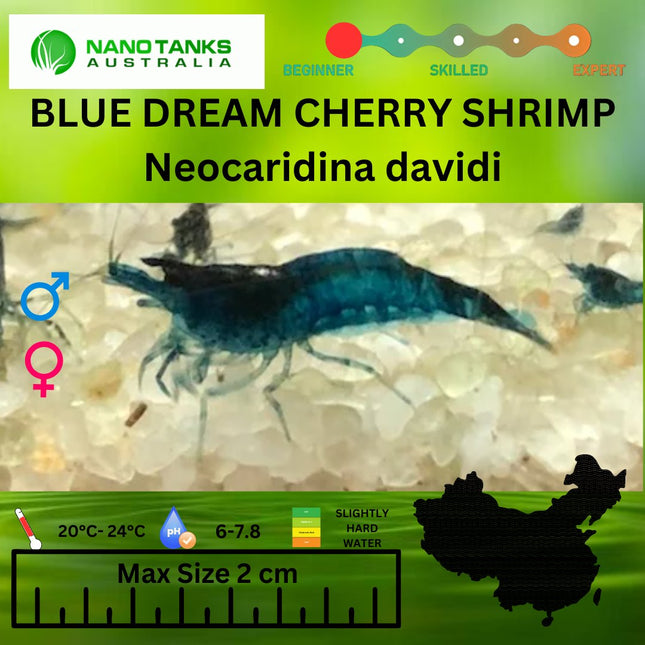
General care for shrimp: Temperature:18°-24°C Chlorine/chloramines: 0 ppm (very toxic for shrimp) Ammonia/Nitrite: 0 ppm. Nitrate: <20 ppm. pH: 6.2-7.5. GH: 4-8 dGH KH: 3-15 dKH Name Optimal TDS Limits Cherry shrimp 150 – 200 100 – 400 Cardinal shrimp 100 50 – 150 Tiger shrimp 180 – 220 100 – 300 We strongly recommend to drip acclimate any shrimp untill the TDS matches before you release the shrimp into your tank. Please note the above is just a general indication of the care requirements of shrimp. Results will vary depending on the individuals set up. NO SHIPPING TO WA
$20.00 $10.00
![Carbon Cherry Shrimp 1 - 3cm [NO SHIPPING TO WA OR TAS] - Nano Tanks Australia Aquarium Shop](http://nanotanksaustralia.com.au/cdn/shop/files/carbon-cherry-shrimp-1-3cm-no-shipping-to-wa-or-tas-701541.jpg?v=1741081843&width=645)
Carbon Cherries comes from blue dream cherry shrimps. These shrimps are more grey in appearance and undesirable when it comes to selective breeding Blue Dream Cherry Shrimps. However they are a strong line and they can give birth to very nice carbon colours with the odd blue cherry shrimps as well. Cherry Shrimps RCS Neocaridina davidi is one of the most beautiful and sought after shrimp in the hobby today. They are easy to care for and easy to breed in a freshwater aquarium. These freshwater shrimps also are priced for the beginners market. Red Cherry Shrimp When you get our shrimps they are mostly a B or C class shrimp. This means that they will appear red, however their quality is not as consistent as the highest grade. We do have Bloody Mary and Fire Red Shrimps that come from time to time however these strains are hard to get and there are cost implication that come with them. If you are interested in these premium kinds of shrimps please message us. Blue Cherry Shrimp & Yellow Cherry Shrimp These colour variations are not as popular as red cherry's however they look amazing in their own way. Our particular variant of Blue Cherry Shrimp is called Blue Dreams. Our Yellow Cherry Shrimps can look quite stunning against particular backgrounds. Living Conditions Dwarf Shrimps are adaptable to a wide variety of tank conditions and water parameters. They can withstand temperatures to around 15°C through to 30°C. However they do prefer to be around 22°C to 26°C. The shrimps are also tolerable in a wide array of pH. However they do better when the pH is around 6.5. RCS (Red Cherry Shrimp) is very tolerable to TDS levels however, we recommend you keep your TDS (Total Dissolved Solids) to around 200ppm max. The History of Shrimp in Australia Red Cherry's appeared in Australia in the early 2000s. The price at this time was quite high and the shrimps unfortunately were not very nicely coloured. The price of the shrimps, fortunately, tumbled quickly as people discovered that they were very easy to care for and breed readily. In 2014 they reached around 50 cents (!!) AUD and people started giving up on these shrimps just because they were easy to breed. When we opened in early 2014 we were fortunate to be the first shop to sell these shrimps in bulk and we were proud to be selling them as low as $1 per shrimp (at that time). However, as we fast forward to the present and beyond, the price of these shrimps has increased steadily due to the necessary upkeep requirements for ensuring healthy shrimps for sale. Now, these shrimps are more than a staple in the Aquarium hobby and a great addition to add for those starting out in shrimp keeping and Aquascaping in general. What fish live with red cherry shrimp? There are a lot of fish that live with red cherry shrimp. You should consider keeping it with anything that won’t target the shrimp. The Red Cherry Shrimps make an irresistible target to predation. To keep it safe and as a rule of thumb, don’t keep shrimps with Barbs, Bettas or anything that can predate it. Even if the fish do not eat the shrimp, having planted aquariums allow for a safe place so your cherries are happy. How long do red cherry shrimp live for? Cherry Shrimps live for around 1-2 years. However, remember that when they are born they are born live and you can observe little shrimps in the tank. Most stores will sell shrimps at around 3-6 months. At this stage it is the best and ideal time for them to go to their new homes. Do Cherry shrimps breed easily? Cherry Shrimps breed very easily and to make sure they do breed, I recommend that you put them in with Bristlenose algae eater. The combination of having a Bristlenose and Cherry Shrimps means that they will consistently breed. Only use a sponge filter and do not keep with other fish if you wish for success. If the tank is new and does not contain sufficient algae, algae wafers are fine to use as this is what baby shrimps eat. Females who are carrying the eggs will have a cluster of between 30 and 50 eggs at a time beneath their tails. Properly bred, 10 shrimps can turn into 1000 in 6 months! Do cherry shrimp need a filter? Cherry shrimps do need a filter to live. However, don’t go overboard on the filtration. A simple sponge filter or internal filter will be more than sufficient for it. Do cherry shrimp eat fish poop? Cherry Shrimps don’t generally eat fish poop, however they will eat Bristlenose poo readily. I believe it is due to the wood that Bristlenose Eat that the Red Cherry Shrimps like as well. I do recommend that you also do feed your Cherry Shrimps to make sure that they are always in great form. Do cherry shrimp jump out of tank? Cherry Shrimps do not necessarily jump out of a tank. However if you give them a way.. like a filter wool climbing area or anything rough they will wonder around. When this happens please make sure that you keep your lids secure. How do you know if cherry shrimp are happy? You know that your cherry shrimps are happy because they will swim around readily and scavenge food in your tank. However, once they become still or unresponsive you will have problems. One of the worst you can ever do with shrimps is when you spray an aerosol in the house. Such as a fly spray or anything that will kill bugs. If and when you do this death will be swift! Why do shrimp drop eggs? Sometimes when RCS molt they might drop their eggs. This means that the eggs were not viable or there is a problem with the water conditions. When this happen we recommend you ignore it at first. However, if this occurs frequently we recommend that you get your water tested to make sure that everything is ok. Are red cherry shrimp Hardy? Red Cherry Shrimps are hardy. They can be totally ignored and you don’t need to really worry about them. The old adage with shrimps is that the more you care for them the worst they can get. What plants do cherry shrimp like? Shrimps loves mosses or anything that they can hide and cover themselves in. If you are looking for things like Susswassertang or Java Moss these are the simplest and the best options. Can cherry shrimp live with bettas? Before we answer the question can Cherry Shrimps live with Bettas, we need to clarify the question further and make it more specific. One betta cannot live with one Cherry Shrimp. One will be food and one will be full. However, if you have 1 betta with say 12 shrimps and heaps of cover in the tank they they can live together with no issues. The reason for this is because it is hard for the betta to focus on the one shrimp. Can you eat red cherry shrimp? You can but why would you? A cherry shrimp is such a small size and you will need a lot of it to really make a meal out of them. If you intend to breed for your human consumption, I would strongly advise against it. We do not send shrimps to WA, TAS or NT
$6.00
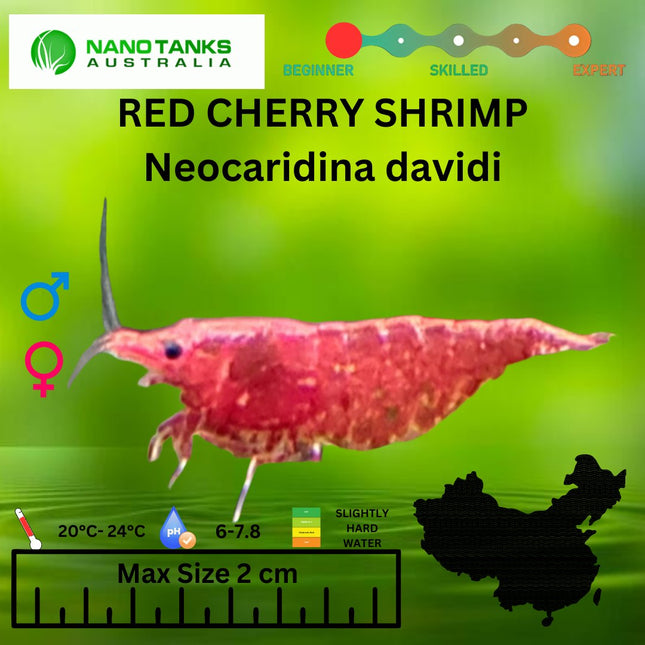
Cherry Shrimp Types & Price Cherry Shrimps RCS Neocaridina davidi is one of the most beautiful and sought after shrimp in the hobby today. They are easy to care for and easy to breed in a freshwater aquarium. These freshwater shrimps also are priced for the beginners market. Red Cherry Shrimp When you get our shrimps they are mostly a B or C class shrimp. This means that they will appear red, however their quality is not as consistent as the highest grade. We do have Bloody Mary and Fire Red Shrimps that come from time to time however these strains are hard to get and there are cost implication that come with them. If you are interested in these premium kinds of shrimps please message us. Blue Cherry Shrimp & Yellow Cherry Shrimp These colour variations are not as popular as red cherry's however they look amazing in their own way. Our particular variant of Blue Cherry Shrimp is called Blue Dreams. Our Yellow Cherry Shrimps can look quite stunning against particular backgrounds. Living Conditions Dwarf Shrimps are adaptable to a wide variety of tank conditions and water parameters. They can withstand temperatures to around 15°C through to 30°C. However they do prefer to be around 22°C to 26°C. The shrimps are also tolerable in a wide array of pH. However they do better when the pH is around 6.5. RCS (Red Cherry Shrimp) is very tolerable to TDS levels however, we recommend you keep your TDS (Total Dissolved Solids) to around 200ppm max. The History of Shrimp in Australia Red Cherry's appeared in Australia in the early 2000s. The price at this time was quite high and the shrimps unfortunately were not very nicely coloured. The price of the shrimps, fortunately, tumbled quickly as people discovered that they were very easy to care for and breed readily. In 2014 they reached around 50 cents (!!) AUD and people started giving up on these shrimps just because they were easy to breed. When we opened in early 2014 we were fortunate to be the first shop to sell these shrimps in bulk and we were proud to be selling them as low as $1 per shrimp (at that time). However, as we fast forward to the present and beyond, the price of these shrimps has increased steadily due to the necessary upkeep requirements for ensuring healthy shrimps for sale. Now, these shrimps are more than a staple in the Aquarium hobby and a great addition to add for those starting out in shrimp keeping and Aquascaping in general. What fish live with red cherry shrimp? There are a lot of fish that live with red cherry shrimp. You should consider keeping it with anything that won’t target the shrimp. The Red Cherry Shrimps make an irresistible target to predation. To keep it safe and as a rule of thumb, don’t keep shrimps with Barbs, Bettas or anything that can predate it. Even if the fish do not eat the shrimp, having planted aquariums allow for a safe place so your cherries are happy. How long do red cherry shrimp live for? Cherry Shrimps live for around 1-2 years. However, remember that when they are born they are born live and you can observe little shrimps in the tank. Most stores will sell shrimps at around 3-6 months. At this stage it is the best and ideal time for them to go to their new homes. Do Cherry shrimps breed easily? Cherry Shrimps breed very easily and to make sure they do breed, I recommend that you put them in with Bristlenose algae eater. The combination of having a Bristlenose and Cherry Shrimps means that they will consistently breed. Only use a sponge filter and do not keep with other fish if you wish for success. If the tank is new and does not contain sufficient algae, algae wafers are fine to use as this is what baby shrimps eat. Females who are carrying the eggs will have a cluster of between 30 and 50 eggs at a time beneath their tails. Properly bred, 10 shrimps can turn into 1000 in 6 months! Do cherry shrimp need a filter? Cherry shrimps do need a filter to live. However, don’t go overboard on the filtration. A simple sponge filter or internal filter will be more than sufficient for it. Do cherry shrimp eat fish poop? Cherry Shrimps don’t generally eat fish poop, however they will eat Bristlenose poo readily. I believe it is due to the wood that Bristlenose Eat that the Red Cherry Shrimps like as well. I do recommend that you also do feed your Cherry Shrimps to make sure that they are always in great form. Do cherry shrimp jump out of tank? Cherry Shrimps do not necessarily jump out of a tank. However if you give them a way.. like a filter wool climbing area or anything rough they will wonder around. When this happens please make sure that you keep your lids secure. How do you know if cherry shrimp are happy? You know that your cherry shrimps are happy because they will swim around readily and scavenge food in your tank. However, once they become still or unresponsive you will have problems. One of the worst you can ever do with shrimps is when you spray an aerosol in the house. Such as a fly spray or anything that will kill bugs. If and when you do this death will be swift! Why do shrimp drop eggs? Sometimes when RCS molt they might drop their eggs. This means that the eggs were not viable or there is a problem with the water conditions. When this happen we recommend you ignore it at first. However, if this occurs frequently we recommend that you get your water tested to make sure that everything is ok. Are red cherry shrimp Hardy? Red Cherry Shrimps are hardy. They can be totally ignored and you don’t need to really worry about them. The old adage with shrimps is that the more you care for them the worst they can get. What plants do cherry shrimp like? Shrimps loves mosses or anything that they can hide and cover themselves in. If you are looking for things like Susswassertang or Java Moss these are the simplest and the best options. Can cherry shrimp live with bettas? Before we answer the question can Cherry Shrimps live with Bettas, we need to clarify the question further and make it more specific. One betta cannot live with one Cherry Shrimp. One will be food and one will be full. However, if you have 1 betta with say 12 shrimps and heaps of cover in the tank they they can live together with no issues. The reason for this is because it is hard for the betta to focus on the one shrimp. Can you eat red cherry shrimp? You can but why would you? A cherry shrimp is such a small size and you will need a lot of it to really make a meal out of them. If you intend to breed for your human consumption, I would strongly advise against it. My shrimps came today and they look transparent! What should I do? When we transport shrimps they may turn transparent as they are stressed. When you put them in the tank their colours will return. We do not send shrimps to WA, TAS or NT
$5.00 $4.00
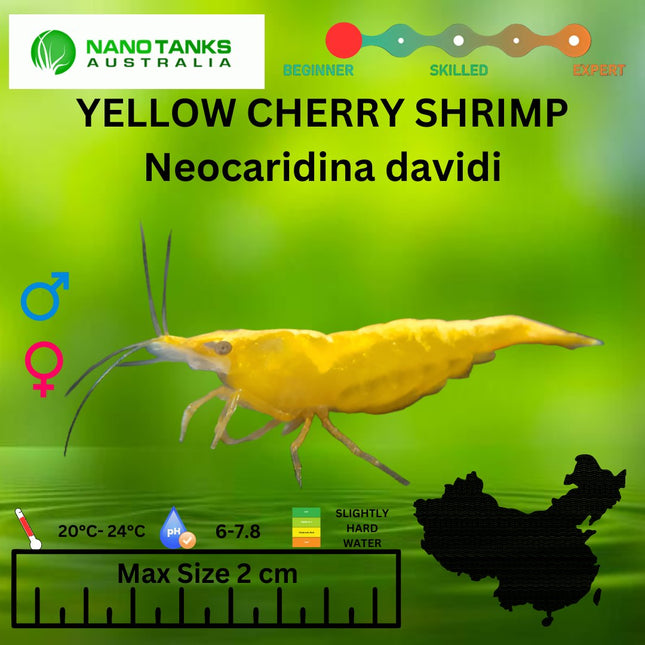
General care for shrimp: Temperature:18°-24°C Chlorine/chloramines: 0 ppm (very toxic for shrimp) Ammonia/Nitrite: 0 ppm. Nitrate: <20 ppm. pH: 6.2-7.5. GH: 4-8 dGH KH: 3-15 dKH Name Optimal TDS Limits Cherry shrimp 150 – 200 100 – 400 Cardinal shrimp 100 50 – 150 Tiger shrimp 180 – 220 100 – 300 We strongly recommend to drip acclimate any shrimp untill the TDS matches before you release the shrimp into your tank. Please note the above is just a general indication of the care requirements of shrimp. Results will vary depending on the individuals set up. Image by: Leah Cattarin NO SHIPPING TO WA
$9.00
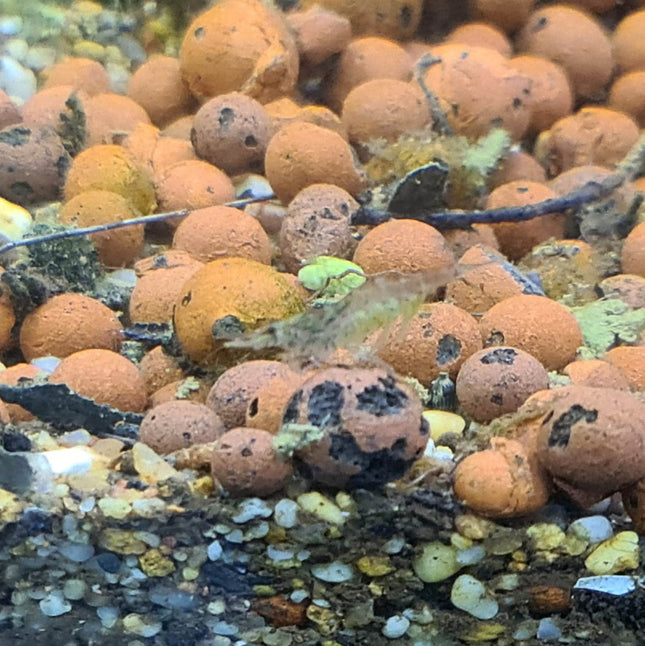
The Glass Shrimps are endemic to Australia and they inhabit many of our inland habitats. They mostly inhabit streams and tributaries on all States in Australia except for Tasmania. They can live in cool conditions (cold winter nights at Sydney) through to to the heat of Sydney's weather. They are an easy species to have and will graze on Algae or uneaten foods. They are not the best when it comes to algae control. Consider giving these gems a try. They reproduce with a planktonic stage and they are quick (as they live with Gambusia and other invasive species). A few people have tried them with Bettas. Although it is not recommended however in a planted Betta tank it is best to have them in a group of 5 or more.
$5.00 $4.00
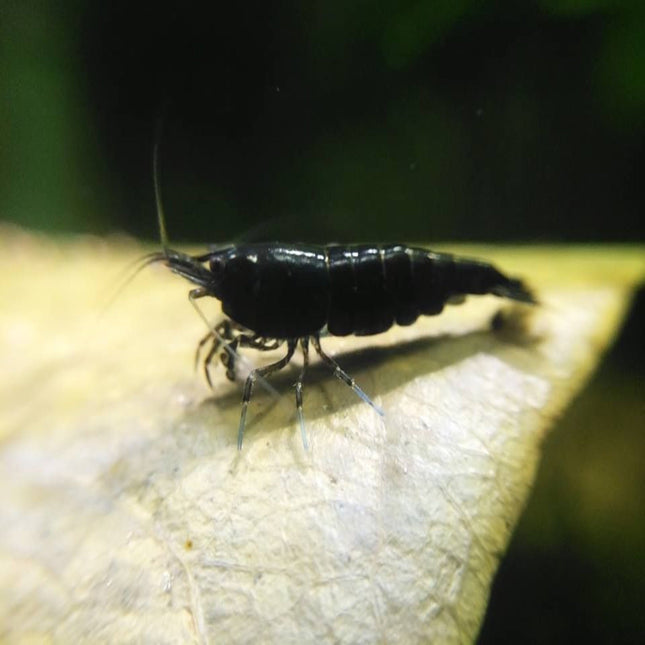
The black variation of the Red Cherry Shrimps All are subadults. Image from https://www.pinterest.com.au/pin/41939840258651870/ NO SHIPPING TO WA
$25.00
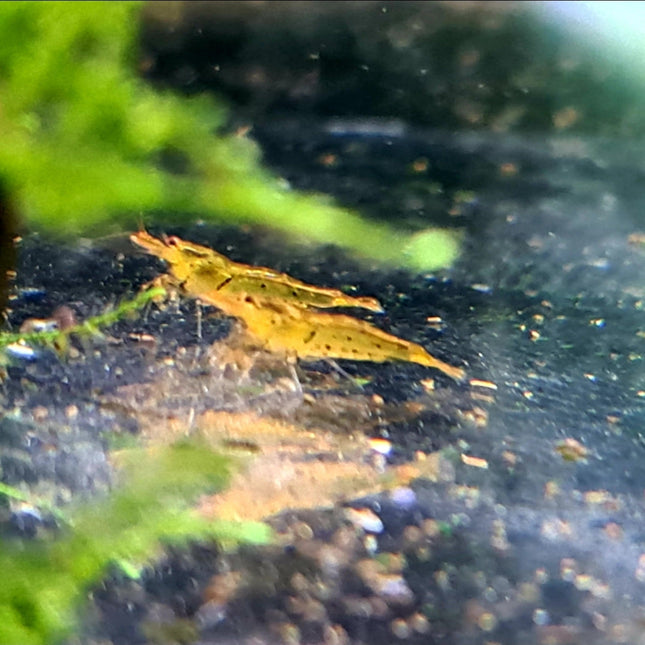
General care for shrimp: Temperature:18°-24°C Chlorine/chloramines: 0 ppm (very toxic for shrimp) Ammonia/Nitrite: 0 ppm. Nitrate: <20 ppm. pH: 6.2-7.5. GH: 4-8 dGH KH: 3-15 dKH Name Optimal TDS Limits Cherry shrimp 150 – 200 100 – 400 Cardinal shrimp 100 50 – 150 Tiger shrimp 180 – 220 100 – 300 We strongly recommend to drip acclimate any shrimp untill the TDS matches before you release the shrimp into your tank. Please note the above is just a general indication of the care requirements of shrimp. Results will vary depending on the individuals set up.
$15.00
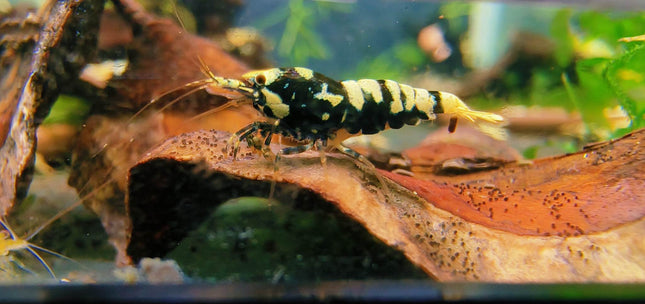
General care for shrimp: Temperature:18°-24°C Chlorine/chloramines: 0 ppm (very toxic for shrimp) Ammonia/Nitrite: 0 ppm. Nitrate: <20 ppm. pH: 6.2-7.5. GH: 4-8 dGH KH: 3-15 dKH Name Optimal TDS Limits Cherry shrimp 150 – 200 100 – 400 Cardinal shrimp 100 50 – 150 Tiger shrimp 180 – 220 100 – 300 We strongly recommend to drip acclimate any shrimp untill the TDS matches before you release the shrimp into your tank. Please note the above is just a general indication of the care requirements of shrimp. Results will vary depending on the individuals set up. NO SHIPPING TO WA
$20.00
![Sunkist Cherry Shrimp 1 - 3cm 1 - 3cm [NO SHIPPING TO WA OR TAS] - Nano Tanks Australia Aquarium Shop](http://nanotanksaustralia.com.au/cdn/shop/files/sunkist-cherry-shrimp-1-3cm-1-3cm-no-shipping-to-wa-or-tas-154148.jpg?v=1738181824&width=645)
General care for shrimp: Temperature:18°-24°C Chlorine/chloramines: 0 ppm (very toxic for shrimp) Ammonia/Nitrite: 0 ppm. Nitrate: <20 ppm. pH: 6.2-7.5. GH: 4-8 dGH KH: 3-15 dKH Name Optimal TDS Limits Cherry shrimp 150 – 200 100 – 400 Cardinal shrimp 100 50 – 150 Tiger shrimp 180 – 220 100 – 300 We strongly recommend to drip acclimate any shrimp untill the TDS matches before you release the shrimp into your tank. Please note the above is just a general indication of the care requirements of shrimp. Results will vary depending on the individuals set up. Image by: Leah Cattarin NO SHIPPING TO WA
$12.00 $9.00
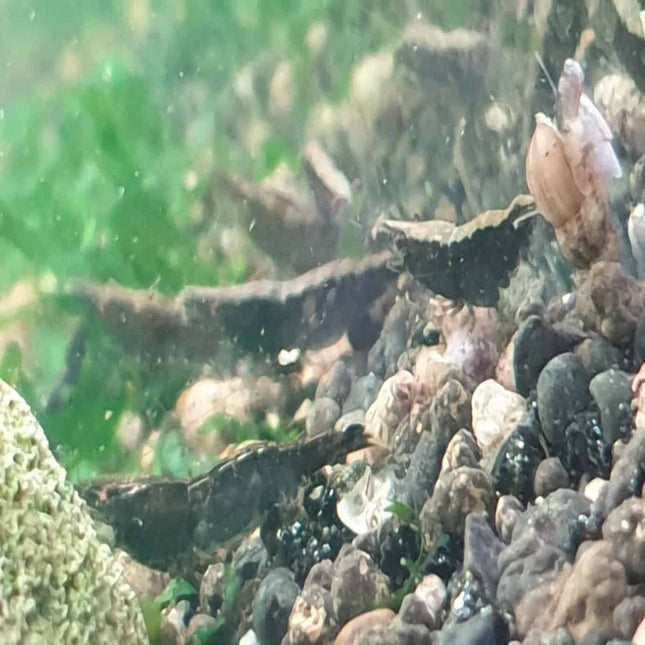
Incredible color-changing ability Relatively rare Completely peaceful disposition Safe with all plants Excellent scavenger RECOMMENDED TANK PARAMETERS: Temperature: 72° - 80° F (22° - 27° C) pH: 6.5 - 8.0 KH: 0 - 10 dKH Minimum tank size: 2 gallons
$7.50 $6.50
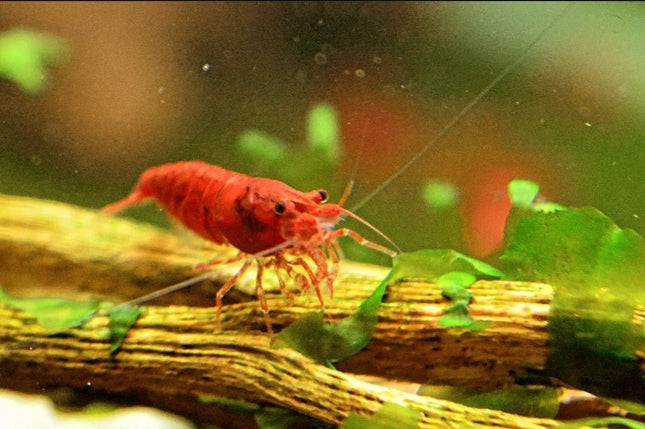
General care for shrimp: Temperature:18°-24°C Chlorine/chloramines: 0 ppm (very toxic for shrimp) Ammonia/Nitrite: 0 ppm. Nitrate: <20 ppm. pH: 6.2-7.5. GH: 4-8 dGH KH: 3-15 dKH Name Optimal TDS Limits Cherry shrimp 150 – 200 100 – 400 Cardinal shrimp 100 50 – 150 Tiger shrimp 180 – 220 100 – 300 We strongly recommend to drip acclimate any shrimp untill the TDS matches before you release the shrimp into your tank. Please note the above is just a general indication of the care requirements of shrimp. Results will vary depending on the individuals set up. NO SHIPPING TO WA
$12.00
🦐 Meet the Macrobrachium Australiense: The Captivating "Predator" of the Freshwater Shrimp World! Step beyond the ordinary with the Long-Armed Freshwater Shrimp, a fascinating and larger-than-life invertebrate that brings a touch of wild, predatory grace to your specialized aquarium. Hailing from the rivers of Northern Australia, this species is not your average cleaner shrimp—it's an active, intelligent hunter and an incredible display animal for experienced aquarists. Witness the ancient dance of survival as it uses its iconic long claws to forage, explore, and command its territory. This is the perfect centerpiece for a species-focused tank. HIGHLIGHTS: Striking & Primitive Appearance: Features remarkably long, slender claws, a translucent body that can display beautiful hues of grey and brown, and prominent, expressive eyes. Active & Engaging Behavior: A captivating display animal that is almost always on the move, hunting, and interacting with its environment. Expert Scavenger: Helps clean the tank by consuming meaty leftovers and detritus, acting as a unique cleanup crew. Breeding Challenge: For the advanced hobbyist, breeding these shrimp in captivity is a rewarding and impressive achievement. SHRIMP CARE & REQUIREMENTS: Scientific Name: Macrobrachium Australiense Common Name: Long-Armed Freshwater Shrimp, Australian Freshwater Prawn, Hunter Shrimp Origin: Northern Australia Tank Size: Minimum 20 gallons for a single specimen due to its territorial nature and size. Water Parameters: Pristine, well-oxygenated freshwater. pH: 7.0-7.8, Temperature: 72-82°F (22-28°C). Requires excellent filtration. Tank Mates: USE EXTREME CAUTION. This is a predatory shrimp. Not suitable for community tanks with small fish, dwarf shrimp, or snails. Best kept in a species-only tank or with large, fast-moving, top-dwelling fish. Diet: Carnivorous/Omnivorous. Requires protein-rich foods: sinking carnivore pellets, frozen bloodworms, brine shrimp, mysis shrimp, and small pieces of fish or mussel. Adult Size: Can reach up to 6 inches (15 cm) in length. WHAT YOU GET: One (1) live Long-Armed Freshwater Shrimp (Macrobrachium Australiense). Size will vary. We ship robust juveniles or sub-adults to ensure you enjoy them for their full lifespan.Please Note: As a wild-caught specimen, color and pattern can vary. They are masters of camouflage. ⚠️ IMPORTANT KEEPER NOTES & FAQ Is this shrimp safe with other fish and shrimp?No. This is the most critical point. The Long-Armed Shrimp is an opportunistic predator. Its natural behavior is to hunt small creatures with its claws. It will see small fish (tetras, guppies), dwarf shrimp (Neocaridina, Caridina), and snails as food. Keeping it with others is done at your own risk. What is the ideal tank setup?Provide plenty of hiding spots and visual barriers using driftwood, rock caves, and PVC pipes. This helps reduce territorial stress if keeping multiple individuals (which requires a very large tank). A secure lid is a must as they can be skilled climbers. Why is it hiding?This is natural behavior. They are often more active during dawn and dusk (crepuscular). After introduction or before a molt, they will hide for security. After molting, they are vulnerable until their new exoskeleton hardens. What do I feed it?While it will scavenge, a dedicated diet of meaty foods is essential for its health and longevity. Offer food directly to it using feeding tongs to ensure it gets enough to eat. 🏞️ THE ULTIMATE PREDATOR TANK!Create a stunning Australian riverbed biotope. Use sandy substrate, river stones, and driftwood. This shrimp is the perfect fascinating inhabitant for a tank that showcases the raw beauty of nature's food chain. 🔒 LIVE ARRIVAL GUARANTEED: This is a hardy but sensitive species. We package with the utmost care using breathable bags, specialized insulation, and a secure box. Please be prepared to acclimate it immediately upon arrival. Review our live arrival policy for complete details. Ready for an advanced invertebrate challenge? Add the formidable Long-Armed Shrimp to your cart!
$20.00
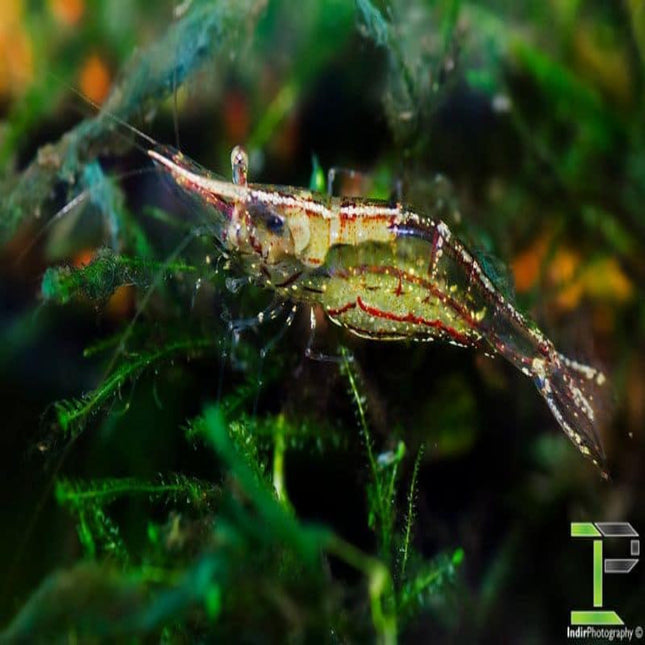
WE DON'T SEND TO TAS OR WA WITHOUT BIOSECURITY CONSENT. Caridina sp NTnilotica - also called ""Darwin Algae Shrimp" or "algae eater shrimp"- is a freshwater species of doube periophthalmate shrimps belonging to the Atyidae family. It was named after P. Roux's research in 1833 and it has its natural habitat over Africa - between the Nile River in Egypt to Lake Sibaya in South Africa and only can be found in Lake Victoria, the source of the Nile River; on other hand according to some sources, this shrimp's homeland is northern Australia, as a significant part of resources on this species belongs there too. There is no doubt the Darwin Algae Shrimp are often confused with Caridina Longistiris. But they differ from each other in many ways. One of their most distinctive features is that it has a white stripe extending from its head to its tail, depending on what time of day or whether it's eating something The males are smaller and less colourful, while the females are larger and more colourful. These shrimps can reach 4-5 cm in length. Water Parameters: pH: 6.5-8 Hardness: soft to hard Temperature: 18-28C Type: Freshwater Darwin algae shrimps prefer to live in aquariums that have high-quality clear water. Unlike snails, they can't tolerate pH levels much either and should be kept in soft or medium hardness environments. However, sudden changes to the temperature of the water will harm them too so it's best to use a heater and thermostat for stability. Darwin algae shrimps are peaceful and will do well with tank mates that are close to its size. It is not able to live in harmony with fish that show territorial protection or large sizes. This can be a problem, as Darwin algae shrimps have been observed being eaten due to their small size from time-to-time. Aggressive and larger fish can always pose a threat, so it may get along better living tanks mates who also have calm behaviour like itself The Caridina sp. Ntnilotica is a shrimp that's generally active in its behavior. This brave shrimp can compete with smaller fish over food and it also has the potential to be hardy if you set up the aquarium properly. If this shrimps movement slows down for just a brief moment, do not worry, as they are cautious around their tankmates so there is no need to panic when this happens! However, if this slowness continues for longer periods of time then it may be due to various diseases that have occured in your shrimp or its habitat… The Darwin Algae Shrimp do not harm aquatic plants, and they mostly live in harmony with them. They are typically preferred to be kept in planted aquariums. Feeding Darwin Algae Shrimp species is a good algae eater. However, their natural feeding areas are the rocky areas densely covered in moss and algae populations. To keep them healthy, it's best to provide an adequate amount of algae or establish one in your tank by exposing rocks or other decorations to high light and moving them into your shrimp tank. If you don't have any on hand - they can be fed dry food occasionally. In addition, if there are microorganisms present that are substantial enough - they will eat those too! But first choice will always be the algae available for consumption. Breeding Little information is available about the reproduction of Darwin Algae Shrimp. There are some observations in Australia for mating time. For instance, before mating, female molts and is surrounded by males during this molting period. After mating the female carries gray eggs that she incubates until they hatch into juvenile shrimp who resemble their parents and then move to a freshwater environment when they grow up in natural conditions (in captivity juveniles must be manually taken from half-strength saltwater over to freshwater). But it's important to provide proper food sources like plankton or otherwise juvenile shrimps will not survive as well Do we have the real deal? A lot of sellers online normally sell Glass Shrimps (Paratya australiensis) and it is very easy to make this mistake as well. In order to resolve the species that we have in stock we have unknowingly done the following: We accidentally sent invertebrates to a customer in Western Australia and it had been ceased by WA Quarantine as Inverts are not allowed in WA. Due to this the package was ceased and awaiting euthanisation. However while waiting for euthanisation the Quarantine Officer decided to put this up for testing. The initial test discovered that this was classified as Paratya australiensis. However later in the day it was pointed that it was a human error where the pheonotype that was used was Paratya australiensis in the WA Quarantine Database. This has been subsequently resolved and the correct name has been established for this species which is Caridina longisrostris. Due to this knowledge and by direct confirmation from Quarantine WA (July 2020). NTA is confident that we sell Caridina longisrostris and not Paratya australiensis. When you purchase from NTA be assured that you will be getting the real shrimps that has been sustainably harvested by a licensed collector from Far North Queensland. What is it good for? Caridina longisrostris is useless on algae that is stuck on the glass or on rocks that has a smooth texture. They will not touch these kinds of algae and it is better that you use Otocinclus for this. What Caridina longisrostris is good for is Black Beard Algae BBA or Green Algae. They will also eat dead or decaying leaves. If there are none of the above they will eat the biofilm in the tank. ONLY if there is nothing left they will eat live plants. However this is very unlikely to occur. Also, another component that we have observed is that these shrimps will eat left over fish food and also will cannibalise if one of the shrimps is weak or there is a failed molt. They will also attack dead fish. Is it right for you? If you enjoy efficient algae cleaning machine this shrimp is for you. When you buy 6 or more it is safe to put it in a Betta tank as well. Photo credit by Indir Tupkovic. Used with Permission. All rights reserved.
$5.00
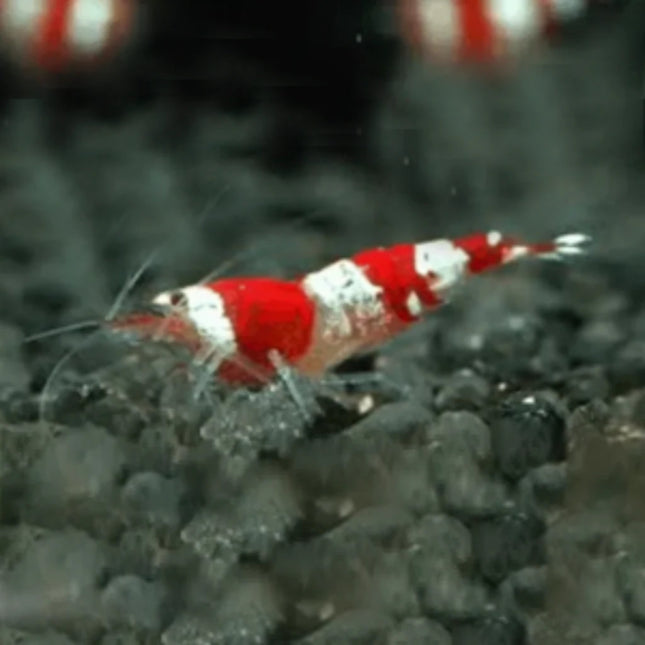
Vibrant Red & White Elegance for Your Aquarium! Short Description:Experience the mesmerizing beauty of Crystal Red Shrimp! These stunning Caridina cantonensis feature brilliant red segments separated by pure white bands, creating a captivating candy-cane effect. A perfect choice for planted tanks and dedicated shrimp colonies, offering both spectacular beauty and beneficial cleaning activity. Key Features & Highlights ❤️ STRIKING RED & WHITE CONTRAST: Vivid red coloration punctuated by bright white bands creates a stunning visual impact that enhances any aquascape ⭐ PREMIUM GENETICS: Carefully selected for intense color saturation and desirable pattern expression - ideal for breeding projects 🌿 NATURAL CLEAN-UP CREW: Constant grazers that help maintain tank cleanliness by consuming biofilm, algae, and organic debris 💧 REWARDING CHALLENGE: Perfect for hobbyists ready to advance beyond beginner shrimp while offering manageable care requirements 👁 CAPTIVATING BEHAVIOR: Active and engaging shrimp that provide endless entertainment as they forage and interact Detailed Description Welcome to the world of Crystal Red Shrimp, one of the most iconic and sought-after dwarf shrimp varieties in the aquarium hobby. These magnificent invertebrates bring an explosion of color and activity to any setup with their striking red and white banding. Each shrimp displays a unique pattern of intense red and crisp white markings, creating a living mosaic that becomes more fascinating as your colony expands. Perfect for intermediate aquarists looking to expand their skills, Crystal Red Shrimp offer the ideal balance of challenge and achievement. They flourish in well-established, stable aquariums where they can exhibit their natural behaviors and maintain their vibrant coloration. Observing a colony of these red-and-white jewels going about their daily activities is like watching living gemstones moving through your aquascape. Whether you're establishing a dedicated shrimp tank or adding spectacular color to a planted aquarium, Crystal Red Shrimp deliver exceptional beauty and practical benefits. Their constant grazing helps maintain tank health while their dazzling appearance provides year-round visual interest. Perfect For: Planted aquariums and nature scapes Dedicated shrimp breeding projects Intermediate hobbyists Aquarists seeking vibrant color contrast Natural biofilm and algae control Specifications & Care Guide Parameter Requirement Scientific Name Caridina cantonensis Tank Size 5-10+ gallons for colony Temperature 64-76°F (18-24°C) pH Range 5.8-6.8 (slightly acidic) GH 4-6 dGH KH 0-2 dKH TDS 100-150 Adult Size 1-1.2 inches (2.5-3 cm) Care Instructions & Feeding Setup: Requires a fully cycled aquarium with stable parameters. Use active substrate for pH buffering and include ample hiding spots with plants, mosses, and hardscape. Feeding: Supplement their natural biofilm diet with specialized shrimp foods, blanched vegetables (zucchini, spinach), and mineral supplements for optimal health and color development. Water Changes: Regular small water changes (10-15% weekly) with remineralized RO or distilled water recommended. Acclimation: Drip acclimate over 2-3 hours due to sensitivity to parameter changes. Important Considerations ⚠️ WATER SENSITIVITY: Sensitive to rapid parameter changes and nitrogen compounds 🚫 COPPER WARNING: Extremely sensitive to copper - avoid copper-based medications 🔬 STABILITY REQUIRED: Require consistent water parameters for long-term success 🦐 TANKMATES: Keep with other peaceful inhabitants or in species-only tanks 🌡 TEMPERATURE CONTROL: Maintain stable temperatures below 76°F (24°C) Live Arrival Guarantee We carefully pack our shrimp with plenty of java moss and protection for their journey. Our live arrival guarantee ensures your Crystal Red Shrimp arrive healthy and active. Please be prepared to acclimate them immediately upon arrival. Create a stunning underwater display with these red-and-white jewels. Add Crystal Red Shrimp to your collection today!
$15.00
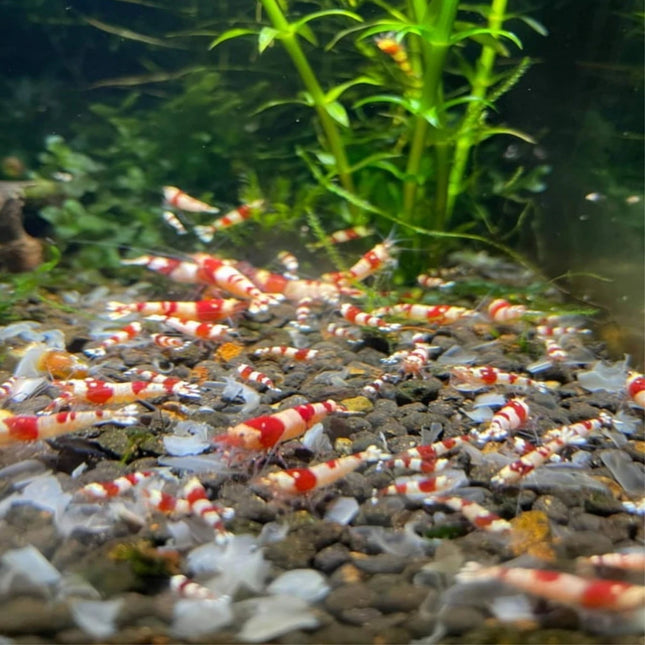
The Pinnacle of Shrimp Keeping: Pure Red Line Crystal Shrimp Short Description:Experience the ultimate in aquatic elegance. Our PRL (Pure Red Line) Crystal Shrimp represent the highest standard of selective breeding, featuring breathtaking, opaque white shells and deep, solid red markings. These are not just shrimp; they are living art for the serious enthusiast, offering an unparalleled challenge and reward. Key Features & Highlights (Bullet Points) 🎨 EXQUISITE COLOR & PATTERN: Meticulously bred for superior genetics, our PRL shrimp boast intensely opaque, snow-white bodies contrasted with rich, blood-red markings. Each shrimp is a masterpiece. 🧬 PURE RED LINE (PRL) GENETICS: This prestigious line is the result of years of selective breeding from the original Crystal Red Shrimp, guaranteeing pattern consistency, color intensity, and superior genetic quality in your colony. 📈 HIGH-GRADE INVESTMENT: We carefully hand-select for grades S+ to SS, ensuring you receive some of the highest-quality shrimp available. These are breeding stock for a thriving, profitable, or show-stopping colony. 🌿 INDICATOR OF WATER PERFECTION: Thriving PRL shrimp are a badge of honor, signifying your ability to maintain pristine, stable water conditions. They are the ultimate test for a dedicated aquarist. 🦐 FASCINATING TO OBSERVE: Watching these translucent beauties graze on biofilm, molt, and care for their young provides endless fascination and a deep sense of accomplishment. Detailed Description Welcome to the big leagues of shrimp keeping. PRL Crystal Shrimp are not your average aquarium inhabitant; they are the result of a passionate global pursuit of perfection. Sourced from top-tier breeders, our stock represents the crème de la crème of the Caridina cantonensis family. Keeping and breeding PRL shrimp is a deeply rewarding hobby that requires attention to detail. They demand specific, soft, acidic water parameters to truly thrive and reveal their full color potential. Success with these jewels means creating a stable, mature aquarium rich in biofilm and devoid of pollutants. This is more than a purchase; it's the start of a project. For those who accept the challenge, the payoff is a self-sustaining colony of some of the most beautiful invertebrates on the planet. This is the journey every serious shrimp keeper aspires to. Ideal For: The Advanced Aquarist Dedicated Shrimp Breeders Aquascapers wanting a premium, colorful clean-up crew Those seeking a rewarding and profitable hobby Specifications & Care Guide (At a Glance) Parameter Requirement Scientific Name Caridina cantonensis var. "PRL" Grade S+ to SS (High Grade) Tank Size Minimum 5 gallons (~20 Liters) Water Temp 62°F - 76°F (17°C - 24°C) pH Level Crucial: 5.8 - 6.8 (Very Soft, Acidic) GH 4-6 dGH KH 0-1 dKH TDS 100-150 Diet Biofilm, specialized shrimp foods (Bacter AE, Shirakura), blanched vegetables, and mineral supplements. Important Notes & Considerations ⚠️ EXPERT-LEVEL CARE: PRL shrimp are NOT for beginners. They require very specific, stable water parameters and are highly sensitive to ammonia, nitrites, and nitrates. Experience with Neocaridina (Cherry Shrimp) is highly recommended first. 🚫 COPPER IS FATAL: Never use medications or plant fertilizers containing copper in a shrimp tank. It is lethal to all invertebrates. 🔬 MATURE TANK REQUIRED: Do not introduce them to a new, uncycled aquarium. The tank must be fully cyclated and mature with a well-established biofilm food source. 🧪 WATER TESTING ESSENTIAL: You must have a reliable liquid test kit (API Freshwater Master Kit) and a TDS/Pen meter to succeed. guessing is not an option. 📦 ACCLIMATION: Drip acclimation over 2-3 hours is absolutely mandatory to avoid osmotic shock due to their sensitivity. Live Arrival Guarantee We understand the investment you are making. Our shrimp are packed with extreme care in breather bags with plenty of moss. Our live arrival guarantee ensures your precious PRL shrimp are delivered safely. Please be ready to drip acclimate them immediately upon arrival. Ready to elevate your aquarium hobby? Invest in the best. Add PRL Crystal Shrimp to your cart today.
$25.00
![[LOCATED OFFSITE ARRIVED 24 - SEP - 2025] Red Fancy Tiger Shrimp 1 - 3cm - Striking Red & White Striped Pattern - Nano Tanks Australia](http://nanotanksaustralia.com.au/cdn/shop/files/located-offsite-arrived-24-sep-2025-red-fancy-tiger-shrimp-1-3cm-striking-red-white-striped-pattern-6881744.jpg?v=1758633593&width=645)
Captivating Stripes, Exceptional Beauty: The Red Fancy Tiger Shrimp Short Description: Elevate your aquarium with the stunning Red Fancy Tiger Shrimp!This extraordinary dwarf shrimp boasts a vibrant red body adorned with crisp, contrasting white stripes, creating a visual masterpiece in any aquascape. A perfect choice for intermediate to advanced hobbyists seeking a unique and rewarding shrimp. --- Key Features & Highlights · 🎨 UNIQUE STRIPED PATTERN: A spectacular red-and-white pattern developed by crossing Tiger and Crystal Red Shrimp, setting it apart from common solid-colored varieties. · 🐠 PEACEFUL SCAVENGER: An active and harmless cleaner that helps manage biofilm, algae, and debris, contributing to a balanced tank ecosystem. · 💎 EYE-CATCHING CONTRAST: The bold stripes create a dazzling display against green aquatic plants and dark substrates, making it a living centerpiece. · 🧬 BREEDER'S DELIGHT: A fascinating project for selective breeding enthusiasts looking to maintain or enhance this distinctive lineage. --- Detailed Description The Red Fancy Tiger Shrimp is a testament to the art of selective breeding. This captivating Caridina variant is known for its energetic personality and stunning appearance, which combines the best traits of its parent species. Its complex ancestry results in a hardy yet exquisite shrimp that is sure to be the highlight of your aquarium. Unlike more common shrimp, the Red Fancy Tiger offers a dynamic and patterned look that adds depth and movement to your tank. Watching a colony of these striped beauties forage and interact is a endlessly fascinating experience. Ideal For: · Intermediate and advanced shrimp keepers · Patterned shrimp breeding projects · Species-only tanks or with other peaceful Caridina · Heavily planted aquariums and nature-style aquascapes --- Specifications & Care Guide Parameter Requirement Scientific Name Caridina mariae "Red Fancy Tiger" Tank Size 10+ gallons recommended Temperature 68°F - 78°F (20°C - 26°C) pH Range 6.0 - 6.8 (Slightly Acidic) GH 4-6 dGH KH 0-2 dKH Diet Omnivore (Biofilm, algae, specialized shrimp foods) Temperament Peaceful --- Important Care Considerations · ⚠️ STABLE WATER CONDITIONS ARE CRITICAL: Like other Caridina shrimp, they are sensitive to fluctuations in water parameters. Consistency is key to success. · 🚫 AVOID PREDATORY TANKMATES: Best kept in a species-only tank or with other very peaceful invertebrates to prevent stress and predation. · 🍽️ SUPPLEMENTAL FEEDING ENCOURAGED: While they will graze on biofilm, a high-quality diet ensures vibrant coloration and health. · 💧 USE A BUFFERING SUBSTRATE: An active substrate is highly recommended to help maintain the soft, acidic water conditions these shrimp thrive in. --- Live Arrival Guarantee We understand the importance of healthy livestock. Our shrimp are carefully acclimated and packed with extreme care. We offer a live arrival guarantee to ensure your Red Fancy Tiger Shrimp arrive safely. Add a stripe of brilliance to your aquarium. Order these unique shrimp today!
$30.00 $20.00
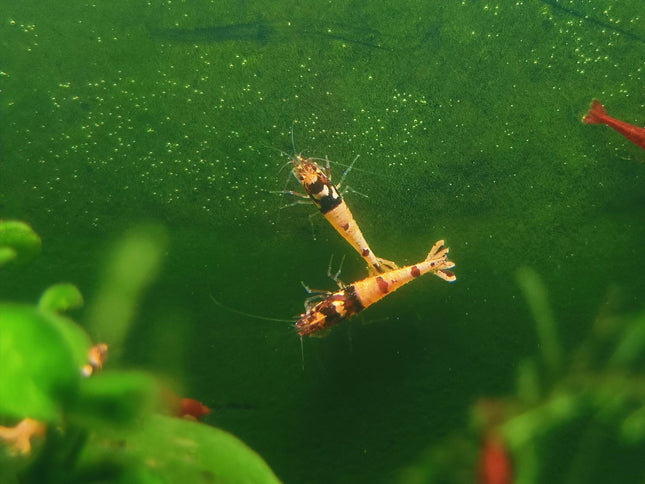
General care for shrimp: Temperature:18°-24°C Chlorine/chloramines: 0 ppm (very toxic for shrimp) Ammonia/Nitrite: 0 ppm. Nitrate: <20 ppm. pH: 6.2-7.5. GH: 4-8 dGH KH: 3-15 dKH Name Optimal TDS Limits Cherry shrimp 150 – 200 100 – 400 Cardinal shrimp 100 50 – 150 Tiger shrimp 180 – 220 100 – 300 We strongly recommend to drip acclimate any shrimp untill the TDS matches before you release the shrimp into your tank. Please note the above is just a general indication of the care requirements of shrimp. Results will vary depending on the individuals set up. NO SHIPPING TO WA
$30.00